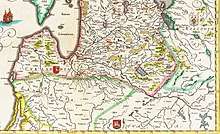Samogitians
Samogitians (Samogitian: Žemaitē, Lithuanian: Žemaičiai, Latvian: Žemaiši, Slavic: Zhmud) are a subgroup of Lithuanians that inhabit the region of Samogitia in Lithuania. Many speak the Samogitian language, sometimes regarded as a dialect of the Lithuanian language.
| Total population | |
|---|---|
| c. 0.5 million in Lithuania (estimated) | |
| Regions with significant populations | |
| Lithuania | |
| Languages | |
| Samogitian dialect, Standard Lithuanian language | |
| Religion | |
| Catholicism | |
| Related ethnic groups | |
| Aukštaitians, Curonians |
Even though Samogitians are politically not considered to be an ethnic group, 2,169 people declared their ethnicity as Samogitian during the Lithuanian census of 2011, of whom 53.9% live in Telšiai County.[1]
History
On 13 July 1260, the Samogitians decisively defeated the joint forces of the Teutonic Knights from Prussia and Livonian Order from Livonia in the Battle of Durbe. Some 150 knights were killed, including Livonian Master Burchard von Hornhausen and Prussian Land Marshal Henrik Botel.[2]
Samogitians lived in western Lithuania and were closely related to Semigallians and Curonians. In 1413, they became the last group of Europeans to convert to Christianity. Samogitians were one of the three main nations of the Grand Duchy of Lithuania, Ruthenia, and Samogitia. In 1857, there were 418,824 people of Samogitian roots and 444,921 persons declared the Samogitian dialect as their mother tongue in 1897 in Kovno Governorate.[3] Currently Lithuania does not allow for declaration of Samogitian nationality in passports as it is not a recognized ethnicity.[4] In list of ethnic groups of Russia there is one person who declared himself with "Zhemaijty".[5]
Exonyms

Samogitians call themselves Žemaitē, although exonyms are used in different languages.
| Language | Samogitia | Samogitians |
|---|---|---|
| Samogitian | Žemaitėjė | žemaitē |
| Lithuanian | Žemaitija | žemaičiai |
| Belarusian | Жамойць | жамойць |
| Yiddish | זאַמעט (Zámet) | זאַמעטער (Zámeter) |
| Estonian | Žemaitija | Žemaidid |
| Dutch | Samogitië | Samogitiërs |
| French | Samogitie | samogitiens |
| German | Schameiten | Schameiten |
| Italian | Samogizia | samogizi |
| Latvian | Žemaitija | žemaiši |
| Polish | Żmudź | Żmudzini |
| Portuguese | Samogícia | samogícios |
| Russian | Жемайтия | жемайты |
| Spanish | Samogitia | samogitios |
| Swedish | Samogitien | Samogitier |
| Ukrainian | Жемайтія | жемайти |
Notes
- Statistics (in Lithuania).
- Ivinskis, Zenonas (1978). Lietuvos istorija iki Vytauto Didžiojo mirties (in Lithuanian). Rome: Lietuvių katalikų mokslo akademija. pp. 184–188. LCC 79346776.
- Petrulis, Valdas (2005). "Žemaitijos etninės savimonės regiono erdvinė struktūra" (PDF). Geografijos metraštis. 38: 163–175. ISSN 0132-3156. Archived from the original (PDF) on 2011-07-22.
- lrytas.lt (2007-06-04). "Žemaičio tautybė - vos porai dienų" (in Lithuanian). Retrieved 2007-11-23.
- Perepis.ru (in Russian)
External links
| Samogitian edition of Wikipedia, the free encyclopedia |